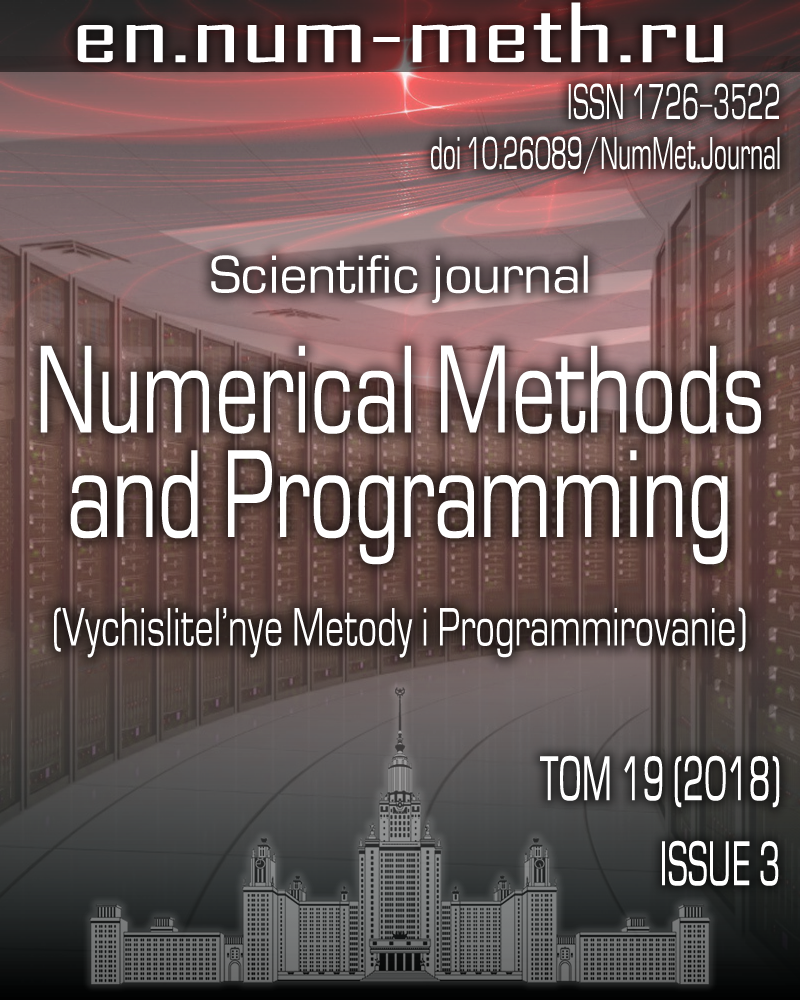DOI: https://doi.org/10.26089/NumMet.v19r324
A method of damped absorption of electromagnetic waves in the numerical simulation of electron beam-plasma interaction
Keywords:
generation of electromagnetic radiation
periodic boundary conditions
Mur’s boundary conditions
absorbing layer
beam injection into plasma
Vlasov equation
Maxwell’s equations
particle-in-cell method
Abstract
The damped absorption as a boundary condition for solving the Maxwell equations by the FDTD (Finite Difference Time Domain) method is considered. Numerical experiments confirm the efficiency of using a simple absorbing layer to absorb the electromagnetic radiation from a point source. The efficiency of using this method to take into account the power of electromagnetic radiation in the numerical simulation of electron beam-plasma interaction by the particle-in-cell method is also shown.
Published
2018-12-26
Issue
Section
Section 1. Numerical methods and applications
References
- Yu. A. Berezin and V. A. Vshivkov, Particle-in-Cell Methods in Rarefied Plasma Dynamics (Nauka, Novosibirsk, 1980) [in Russian].
- Yu. N. Grigor’ev, V. A. Vshivkov, and M. P. Fedoruk, Numerical Modeling by Particle-in-Cell Methods (Ross. Akad. Nauk, Novosibirsk, 2004) [in Russian].
- E. A. Berendeev, G. I. Dudnikova, and A. A. Efimova, “PIC-Simulation of the Electron Beam Interaction with Modulated Density Plasma,” AIP Conf. Proc. 1895 (2017).
doi 10.1063/1.5007419 - E. Berendeev, M. Boronina, G. Dudnikova, et al., “Supercomputer Modeling of Generation of Electromagnetic Radiation by Beam-Plasma Interaction,” in Parallel Computational Technologies (Springer, Cham, 2017), pp. 247-260.
- A. Taflove and S. C. Hagness, Computational Electrodynamics: The Finite-Difference Time-Domain Method (Artech House, Boston, 2005).
- G. Mur, “Absorbing Boundary Conditions for the Finite-Difference Approximation of the Time-Domain Electromagnetic-Field Equations,” IEEE Trans. Electromagn. Compat. EMC-23} (4), 377-382 (1981).
- Z. P. Liao, H. L. Wong, B. P. Yang, and Y. F. Yuan, “A Transmitting Boundary for Transient Wave Analyses,” Sci. Sinica, Ser. A 27, 1063-1076 (1984).
- J.-P. Berenger, “A Perfectly Matched Layer for the Absorption of Electromagnetic Waves,” J. Comput. Phys. 114 (2), 185-200 (1994).
- S. D. Gedney, “An Anisotropic Perfectly Matched Layer-Absorbing Medium for the Truncation of FDTD Lattices,” IEEE Trans. Antennas Propag. 44 (12), 1630-1639 (1996).
- A. B. Langdon and B. F. Lasinski, “Electromagnetic and Relativistic Plasma Simulation Models,” Meth. Comput. Phys. 16, 327-366 (1976).
- A. V. Arzhannikov, A. V. Burdakov, V. S. Burmasov, et al., “Dynamics and Spectral Composition of Subterahertz Emission from Plasma Column Due to Two-Stream Instability of Strong Relativistic Electron Beam,” IEEE Trans. Terahertz Sci. Technol. 6 (2), 245-252 (2016).
- I. V. Timofeev, V. V. Annenkov, and A. V. Arzhannikov, “Regimes of Enhanced Electromagnetic Emission in Beam-Plasma Interactions,” Phys. Plasmas 22 (2015).
doi 10.1063/1.4935890 - V. V. Annenkov, I. V. Timofeev, and E. P. Volchok, “Simulations of Electromagnetic Emissions Produced in a Thin Plasma by a Continuously Injected Electron Beam,” Phys. Plasmas 23 (2016).
doi 10.1063/1.4948425 - R. W. Hockney and J. W. Eastwood, Computer Simulation Using Particles (McGraw-Hill, New York, 1981; Mir, Moscow, 1987).
- J. P. Boris, “Relativistic Plasma Simulation - Optimization of a Hybrid Code,” in Proc. Fourth Conf. on Numerical Simulation of Plasmas, Washington, DC, USA, November 2-3, 1970 (Naval Res. Lab., Washington, DC, 1971), pp. 3-67.


